Preparation of ExoMars mission. Preliminary study for 3D and stereo science operations by using CLUPI flight model representative: Toward a morphometrical analysis
- 1Space Exploration Institute, Faubourg de l’Hôpital 68, CH-2000, Neuchâtel, Switzerland
- 2Laboratoire d’Astrophysique de Marseille, LAM, UMR7326, CNES, CNRS-INSU, Université d’Aix-Marseille, France
- 3University of Basel, Dpt of Environmental Sciences, Physical Geography and Environmental Change, 4056, Basel, Switzerland
- Introduction
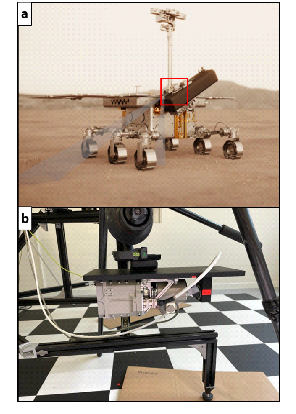
Figure 1: Rosalind Franklin rover . (a) CLUPI on the drill box (red rectangle, Image credit ESA/SEI-TJ). (b) CLUPI flight model representative (EM+) mounted in the stowed drill configuration, Image credit SEI.
Therefore, for this scientific goal, the objective is to reconstruct topographical and 3D data from the CLUPI data, using specific CLUPI operating configurations. This project is in collaboration with the Laboratoire d’Astrophysique de Marseille (LAM, France).
- 3D and stereo with CLUPI
CLUPI 8 configurations are linked to the drill box positions (Fig.2, Josset et al., 2017). In order to constrain the topographical data from the images acquired by CLUPI we will used the stereogrammetry method (Beyer et al., 2018). To perform that we need several images of the same geological target but with different stereo-angle (i.e. the angle between the target and CLUPI in the target repository (Fig.3)). CLUPI is a mono optics camera system. Thus, the different shots resulting in different stereo angles will come from the movement of the drill box and/or the rover itself. So, the main question of this project is how to define the optimal geometries parameters to obtain stereo images of the same target according to the 8 CLUPI operating configurations?
- Experimentation and preliminary result
In order to simulate the operation environment of CLUPI, we are using the EM+ flight model representative in the Space Exploration Institute CLUPI science operation lab based in Microcity, Neuchâtel, Switzerland. The CLUPI EM+ is adapted on a geometric drill simulator, corresponding to the ExoMars Rover mission (Josset et al., 2017). The objectives of this experimentation are to (1) recreate the CLUPI operating configurations, (2) vary parameters such as: the angle of incidence, the working distance and the CLUPI height relative to the ground; the illumination (studied in Marslabor, University of Basel; Bontognalli et al., 2021), and (3) derived the best geometrical position of the rover in order to reconstruct topographical data (Fig.3a).
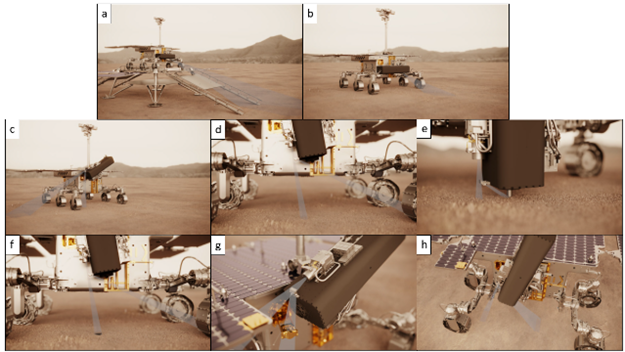
Figure 2: CLUPI eight operational configurations. (a) On the platform, (b) geological environment survey, (c) Close-up outcrops observation, (d) drilling area observation, (e) drilling operation observation, (f) Drill hole and fines observation, (g) drilled core sample observation and (h) calibration: calibration target imaging. Images credit: ESA/SEI-TJ
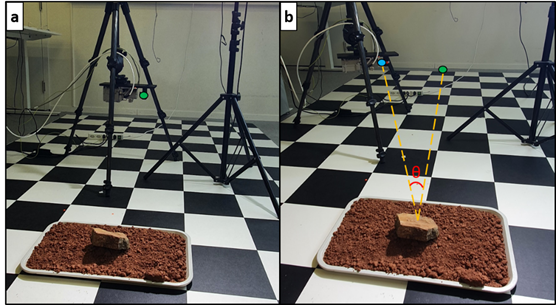
Figure 3: Experiment with the EM+. (a) Simulation of the second configuration. (b) Simulation of the second configuration after the calculated translation and rotation of the "rover", with a stereo angle (red) and the same working distance (yellow). The green and blue points correspond, respectively to the EM+ position before and after the translation/rotation.
- Illumination study (Basel University)
The total light and direction of incidence light plays an important role in allowing the identification of different rock textures, morphological features, and mineralogical distribution. The effect of different solar angles in relation to the target rock is studied with CLUPI analogue camera - Canon EOS M50. The most recent results show that to identify sedimentary structures, such as cracks, laminations and other morphological features in sedimentary rocks, the lower angle of 25° of direct light is preferable (sunset conditions on Mars, Fig.4a, c). In contrast, the distribution of the minerals within the rock, the incident/direct light shall be around 70° to the rock surface (mid-day conditions on Mars, Fig.4b,d).
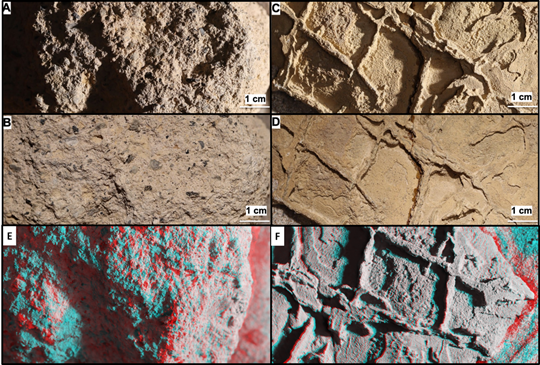
Figure 4. Close-up images in third configuration of basaltic tuff (A&B) and dry cracks in sedimentary rock (C&D) taken with Canon EOS M50 in Marslabor at University of Basel. (a) and (c) direct light of the angle 25 °. (b) and (d) direct light of an angle 70 °. Each to the rock surface. The total proportion of the light was 5:1 of direct and diffused light - 5000 LUX and 1000 LUX respectively, after Bontognali et al., 2021. With a working distance of 650 mm and camera angle of 11 °. (e) and (f) are anaglyph made from basaltic tuff (a) and (b) and dry cracks in sedimentary rock with the Canon, 25° light angle and a working distance of 760 mm.
- Stereo and 3D study (Space Exploration institute, Neuchâtel)
Currently, we succeed to define the optimal positions, with respect to configuration 2 and 3. For the configuration 2, the images with different stereo angle come from a translation then a rotation of the rover (Fig.3). The stereo images from the configuration 3 come from the different drill positions. In these two cases, the calculated positions make it possible to keep the same working distance despite the movements. This point is particularly important to reconstruct the topography rigorously.
We also reconstruct the firsts 3D anaglyphs based on the third configuration (Fig.4e, f and Fig.5).
- Conclusion and acknowledgment:
These study and related experiments consisting in varying the following parameters: the angle of incidence, the illumination, the working distance, the height relative to the ground, allows to faithfully reproduce the CLUPI operations configurations. These first results are promising since we succeed to define the geometrical parameters optimally to derive the topography data for 2 configurations. We will continue to investigate on the other configurations to quantify the rock morphometry recorded in the rock matrix. These steps are essential to significantly increase the science exploitation of CLUPI. The authors want to acknowledge the Swiss National Science Foundation (Subside 200021_197293/1), who is funding this project with the support of the Swiss Space Office and ESA Prodex.
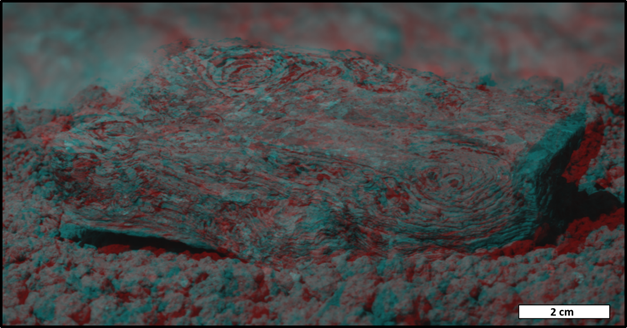
Figure 5: Anaglyph of a stromatolite performed in the SEI/Lab using CLUPI Flight Model Representative in the third configuration with a working distance of 1 m and a stereo angle of 10°. Images credit: SEI.
References:
Beyer, R. A., Alexandrov, O., & McMichael, S. 2018, Earth and Space Science, 5, 537– 548.
Bontognali, T., Meister, Y., Kuhn, B., et al., 2021, Planetary and Space Science, 208, 2021, 105355
Bouquety, A., Sejourné, A., Costard, F., et al., 2019, Geomorphology, 334, 91
Bouquety, A., Sejourné, A., Costard, F., et al., 2020, Geomorphology, 350, 106858
Bouquety, A., Jorda, L., Groussin, O., et al. 2021, Astronomy & Astrophysics,649, A82
Bouquety, A.,Groussin, O., Jorda, L., et al. 2022, Astronomy & Astrophysics: https://doi.org/10.1051/0004-6361/202142417
Josset, J.-L., Westall, F., Hofmann, et al., 2017. Astrobiology 17, 595–611.
How to cite: Bouquety, A., Jorda, L., Ligeza, G., Fayon, L., Narbey, R., Josset, T., Bontognali, T., Kuhn, N., and Josset, J.-L.: Preparation of ExoMars mission. Preliminary study for 3D and stereo science operations by using CLUPI flight model representative: Toward a morphometrical analysis, Europlanet Science Congress 2022, Granada, Spain, 18–23 Sep 2022, EPSC2022-1255, https://doi.org/10.5194/epsc2022-1255, 2022.

